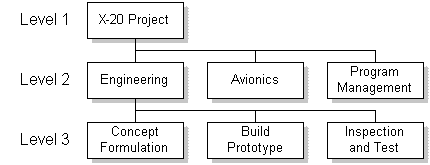
A Work Breakdown Structure (WBS) is an organized framework in which you can progressively subdivide a project's work content into elements that can be easily identified and tracked. Using the WBS methodology:
Makes planning, scheduling, estimating, and reporting easy
Provides the framework for cost collection and responsibility assignment
Provides detail and summary reporting of cost, schedule, and performance
MPM's design is based on the government's concept of supplying data by WBS, OBS, and EOC. Government contractors managing major procurements generally follow the guidelines detailed in MS-881 (DOD) and MA-0295 (DOE).
A WBS element is a product, set of data, or service produced by the project. The collection of all WBS elements in a project, organized into levels, is called the WBS Tree.
A WBS element that has one or more sub-elements is known as a parent element or a parent. Each sub-element under the parent element is known as a child element or child. A WBS Tree with at least three levels may also contain grandparents and grandchildren.
In the example below, the WBS elements in Level 2 are: Engineering, Avionics, and Program Mgmt and the Level 2 element, Engineering, is a parent element with three children (Concept Formulation, Build Prototype, and Inspection & Test). These three elements are grandchildren of the Project Level 1.

In the diagram above, the WBS elements in Level 3 all roll up to Level 2, the Cost Account elements, meaning that all cost, schedule, and performance data in these children will roll up creating totals at the parent level.
For example, all of the costs, schedule, resources, and performance data associated with the Level 3 WBS element Concept Formulation, together with those of Build Prototype and Inspection & Test, will be rolled up into Engineering. This allows the project leaders of the X-20 Project to know how much it cost to do the engineering segment of the X-20 project, how long it took, and how well the participants stayed within the baseline schedule and budget of the project. Using the rolled up data, you can then generate management reports showing both detailed and summary information.
In the table that follows, the Estimated time, Estimated cost, Time spent so far, Cost so far, and Percent complete for the three child elements at Level 3 roll up into the parent at Level 2. MPM individually adds the estimates and actuals of the children, and their totals are saved at the parent level.
|
Preliminary Study |
Engineering Design |
Detail Design |
Concept Formulation |
Estimated time: |
6 months |
9 months |
6 months |
21 months |
Estimated cost: |
$100,000 |
$70,000 |
$70,000 |
$250,000 |
Time spend so for: |
3 months |
2 months |
0 months |
3 months |
Costs so far: |
$40,000 |
$20,000 |
$0 |
$60,000 |
Percent complete |
35% |
15% |
0% |
25% |
The Total Estimated Time (not elapsed time) to complete the tasks for all three child elements, 21 months, becomes the estimated time to complete the task at Level 3, Concept Formulation. The Total Estimated Cost of $240,000, becomes the estimated cost at Level 3. The project has started and three months have elapsed. Preliminary Study is about 35% complete after three months of work and has cost $40,000 so far. Engineering Design is about 15% complete after two months of work and has cost $20,000 so far. Detail Design hasn't started yet.
So the Concept Formulation portion of the project has spent three months (elapsed time) and $60,000 so far, and is about 25% complete. Estimating the time and cost that it will take to complete the tasks (Estimate To Complete - ETC and Budgeted Cost of Work Scheduled - BCWS) and then adding that estimate to the actuals so far, we can get an idea of how closely the project is following what was estimated.